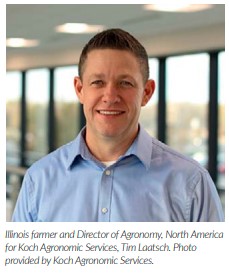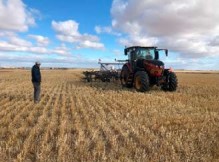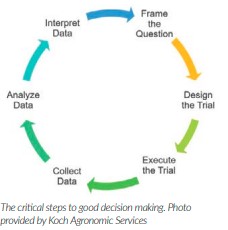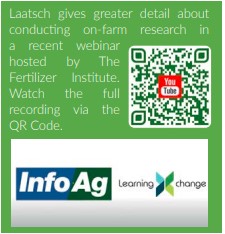Written By Laura Barrera and first published on AgFuse.com
If you want to make smart, well-informed decisions on your operation, you need relevant, high-quality data to support those decisions, says Tim Laatsch. A great way to achieve this? On-farm research.
An Illinois-based farmer, Laatsch knows first-hand the importance of on-farm research. As the Director of Agronomy, North America for Koch Agronomic Services (Koch), he leads a team of agronomists responsible for developing and executing field research strategy.

Here he shares the steps to follow for conducting on-farm research and the best strategies for ensuring it’s a successful endeavor.
- Frame Your Research
Question
The first step to getting started with on-farm research is to ask yourself why you’re doing it, Laatsch says. “If profitable decision-making is their goal, it’s worth the time and effort to do the job the right way,” he explains. “Because the decisions they make as an outcropping of the research could potentially impact their profitability for years to come.” The key is to keep it simple and only focus on one management change at a time, as one of the initial mistakes farmers make with on-farm research is trying to answer too many questions at once.
Laatsch highly recommends working with a qualified expert on this. In addition to helping you come up with the right question to ask, they can also provide guidance and support throughout the trial. Once you’ve determined the one question you’re trying to answer, then you need to come up with your hypothesis. Laatsch recommends the following format:
• Start with a basic problem statement: “The problem is X…”
• Come up with a potential solution: “I believe that X…”
• Determine what you hope to achieve: “Will result in X…”
For example: “The problem is I apply twothirds of my nitrogen prior to planting and I’m concerned I may be losing nitrogen and sacrificing yield opportunity. I believe that using a nitrification inhibitor will reduce nitrification loss, which will result in higher corn grain yields.” The last part of creating your hypothesis is to define the outcome. Laatsch says this part is most often neglected when framing the question. “Not making an educated guess about the results before the research begins is a mistake that’s made at times,” he says. “What we should do is define on the front end our standard of success.”
It needs to be more specific than just “higher yield” or “reduced fertilizer inputs.” Laatsch suggests that you include your level of confidence in the treatment, and specify the number of environments it needs to be tested across, as there may be some environments where you expect more or less change. For example: “We will have the confidence to make a decision when the yield increase is X bushels per acre, with a minimum of 80% statistical confidence across three locations.”

Statistical confidence is simply an outcropping of being able to measure the variation around the average, Laatsch says. In other words, what are the odds that the result is due to your treatment and not by chance or another factor? So what should your confidence level be? Often 95% is used in university research and scientific literature, but for farmers, that probably sets the standard too high.
“There’s a very good chance you will reject a viable technology [at 95%],” he says. “Maybe 80% would be a more reasonable starting point. I’ll take a bet that 80% probability of a product will create more yield for me.” Again, working with an expert who is familiar with using statistics in on-farm research would be helpful in determining what the confidence level should be.
2. Design the Trial
The lack of statistical confidence is also why single side-by-side or field-by-field comparison research trials are flawed, Laatsch says. That’s because they don’t account for in-field variability, so you can’t run an analysis of variance on them. Laatsch made this mistake with his own on-farm research. He was testing foliar fungicides, and since he was aerially applying them, it would have been difficult to do replications, so he stuck with side-by-sides. But at the end of the season, he couldn’t readily determine whether those applications generated a positive ROI.
“There were places where it seemed like it performed well, other places where I couldn’t tell the difference,” he says. “I had no ability to measure the variation around the mean or to have any degree of actual calculated statistical confidence in the outcome. As a consequence, now I’m in the position where I can’t make that decision.”
That doesn’t mean you can’t do side-by-side plots. In fact, Laatsch recommends them because they’re the simplest to implement. The key is to make sure you’re including repetitions. In the example of the nitrification inhibitor trial, you’d include one strip with the nitrification inhibitor and one without it (i.e., your control) and repeat those throughout the field or across multiple fields. To run an analysis of variance, you need at least 3 replications, preferably 4 to 6. That way if weather or some event takes out one of your replications, you’re not down to two.

One design option is a randomized complete block design. In this trial design, your treatment may be on the left in one replication, and then on the right in another, to help eliminate field biases. Modern GPS makes this design easier to implement because you can put in all your treatments and then fill the gaps on the way back, Laatsch says. But the easiest and quickest way of setting these trials up is to split your planter or applicator. This eliminates randomization, but Laatsch says in most on-farm research that’s probably fine. Having field-scale equipment already provides an inherent advantage because you can do larger plot sizes, reducing variability.
While a replicated trial within one field is probably sufficient to manage your decision-making risk, Laatsch encourages you to think about whether there are major differences in soil environments across your operation. If there are, consider repeating the trial within each of those environments to better understand whether the treatment you’re testing is beneficial across the whole farm. “The most powerful research designs have the greatest ability to impart statistical confidence, have fewer treatments, and only focus on one factor at a time,” says Laatsch. Again, this is another step where having a trusted partner is useful because they can guide the trial design and determine where to place it on the farm.
However you design your trial, don’t forget to include buffers, Laatsch says, because excluding them can skew your results. For instance, including an outside row that receives open sunlight exposure could increase yield, creating a favorable advantage. Instead, keep those outside edges out of the trial, and consider having harvest buffers within treatment cells to ensure you don’t have overlapping edge effects between treatments.
3. Execute the Trial
With your hypothesis and trial design in place, the next step is executing the research. Laatsch’s No. 1 piece of advice for doing this currently is to have that trusted partner on site. They can help with taking measurements, laying out treatments, and marking plot corners, so you can stay in the cab. “It’s very time efficient and improves accuracy if you have actual physical boots on the ground to help with trial implementation,” he says. But before you even head out into the field, you need to plan ahead. Laatsch says the last thing you want to do is get caught in the position of making design decisions on the fly because you’re under pressure. You’ll want to make sure the design, the repetitions and the treatments are all defined ahead of time.
He gives the example of a grower and retailer he knew who started a trial in the heat of planting season, on a Saturday evening. The trial was a total loss because they later discovered they had an old product label and applied the wrong rate. “It’s just an example of making sure you’ve got everything typed out, including product rate, before you go to the field,” he says. “If you’re trying to do that on a Saturday night, you may not be able to access resources that can answer questions.”
Documentation is critical to trial execution and redundancy is good. You don’t want to rely strictly on digital or physical documents, so keeping both is a good idea in case one of them fails, especially when it comes to marking your plots. Other factors to document include the conditions at the time, and you need to capture those in the moment. “If you don’t write that stuff down, you will never remember it when you get back to the end of the season and you’re trying to interpret your results,” Laatsch says.
Finally — and as a farmer, Laatsch can attest this is the hardest part — you need to slow down. “The pressure of spring planting can create all kinds of problems, in terms of temptations, to cut corners,” he says. “You’ve got to slow down to get better.” The consequences of failing to do so can be detrimental to your farm’s profitability. If you make a decision based on the results of a rushed and poorly executed trial, it can cost you money for years.

4. Collect Accurate Data
The next step is collecting data, which is determined by your research question. “You really need to decide upfront what you’re going to measure before you start the trial,” Laatsch says. There are two kinds of variables you need to measure in your research: independent and dependent. Dependent variables rely on the treatment you’re implementing — they’re outcomes of what you’re testing. Changes in plant nutrient concentration, plant growth rates, crop health, and grain yield, moisture or quality, are all examples of dependent variables. Independent variables are factors not influenced by your treatment that could affect your results, such as weather, soil type, and growing degree days. These are important to measure because they can help explain why you got the result you did.
The proper equipment calibration of tools, like yield monitors, is key for accurate data collection. While Laatsch admits those technologies are getting better every day, “there’s nothing like having a calibrated scale that you’re actually weighing grain on in the field,” for the most reliable result.
5. Analyze Your Results
It can be easy to look at the results on the surface and judge whether it was a success. But Laatsch implores farmers to take it a step further and look at the results’ statistical confidence. If this isn’t something you’re familiar with, he recommends working with someone who has that expertise. Look for someone who has an advanced degree in agronomy, as that normally signifies a formal training in statistics. You can also partner with a third-party service provider or reputable company who may have a research agronomist on staff that can help.
6. Study Up and Check Yourself
The best way to succeed with on-farm research is to do your own research. Laatsch says there are plenty of wellwritten guides to doing on-farm research that are just a Google search away. “One way to prevent mistakes is to just study up on technique and become a student of the process,” he says. He adds that one of the best ways to set yourself up for success is to create a checklist for the entire process. As you move through the field and through the season, you’ll have a way of ensuring you’re following the protocols you’ve set out for your research.
“At the end of the day, you never want to make a bad decision based on weak or inadequate data,” Laatsch says. “That’s what’s driving all of this. You’ve got to be cognizant of why you’re doing this and the level of effort that is going to be required to get good data to support that decision.”
For more information about on-farm research…
